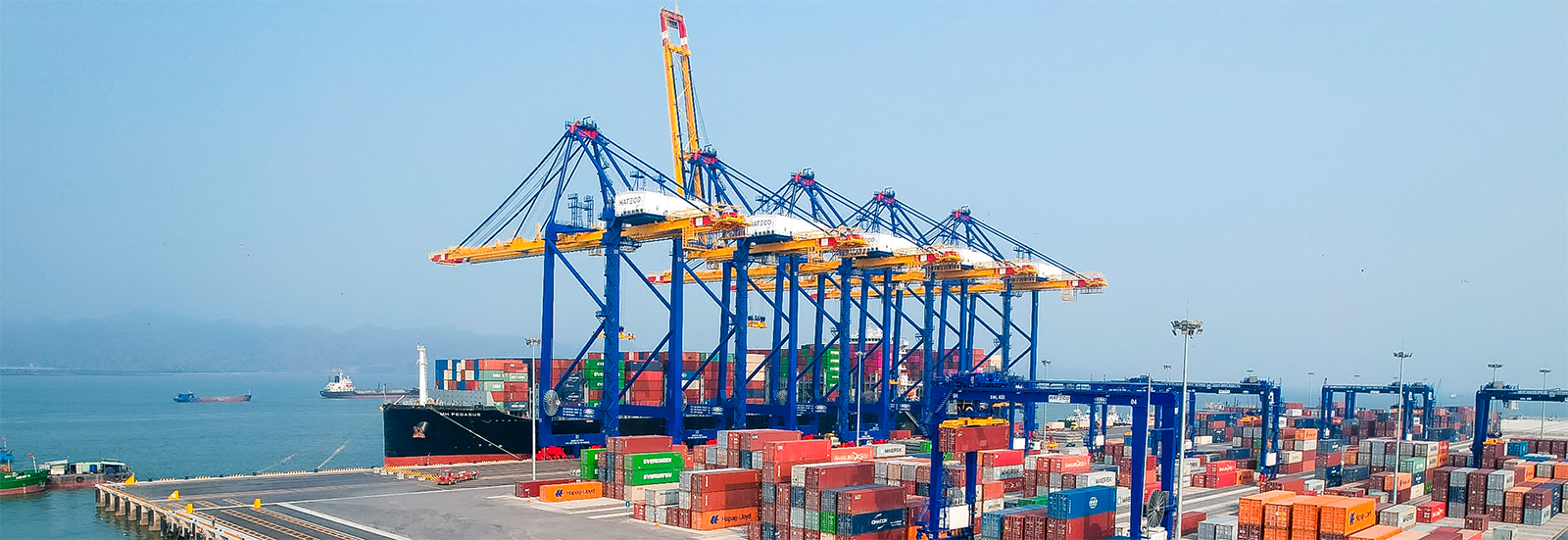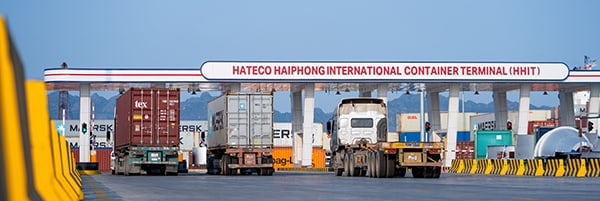
Transforming Hai Phong: HHIT’s smart port success
|
Originally published in Port Technology International. |
There was a time when global trade and the terminal business operated quietly in the background, but today, the port industry finds itself in the spotlight more than ever. A port is part of a nation’s critical infrastructure. The COVID-19 pandemic, geopolitical conflicts, and changing trade landscapes have exposed supply chain vulnerabilities, and disruptions have become the new normal we must work with.
For APM Terminals, this means that within the current state of global trade, there are two important things to deliver on from a terminal’s perspective, no matter where we operate: reliability and flexibility.
Delivering on this can make all the difference to customers in a situation where there are major uncertainties and abrupt shifts. However, as a global company with more than 60 terminals in 33 countries, it is important to recognise that one size does not fit all, and thinking beyond the gates of the container terminal should be part of our approach when designing, developing, and running both new and existing terminals. Combining our global mindset with local expertise is central to integrating mental agility and multi-perspective thinking, ensuring we build a successful terminal that will support the growth and logistics flow of each country we serve.
Partnering for success
A recent example of this is the opening of the Hateco Hai Phong International Container Terminal (HHIT) in Hai Phong, Vietnam, in early February 2025. HHIT’s successful go-live, under the leadership of its CEO, Mr. Nguyễn Văn Tiến, is the most recent illustration of a successful strategic partnership where each party contributes their expertise.
In 2023, APM Terminals committed to being a strategic partner of the deep-water port, using our global expertise and best practices to advise Hateco on developing a successful container terminal that could attract and service mega-vessels of up to 18,000 TEU in size, thereby reducing import and export costs in an area of crucial importance to Vietnam’s growth and to intra-Asian and Transpacific trade.
Analysing how the terminal and its teams succeeded in making a record-fast delivery – from the beginning of land reclamation and construction to go live in only 30 months, followed by a rapid ramp-up – it is evident that the combination of the right partnership, modern technological solutions, and putting people at the centre was the recipe for success.
Harnessing digital for smoother supply chains
HHIT has deployed several digital solutions worth highlighting as important enablers. One is the use of Navis N4 4.0 TOS, another is the Autogate and Truck Appointment System (TAS) combination. The latter is a first for North Vietnam; no other terminal in the area has implemented it, and it has demonstrably impacted the entire supply chain, not just port flow.
A Terminal Operating System (TOS) is a softwares platform
used to manage and optimise the movement, storage and tracking
of cargo, equipment and operations across the terminal.
Timing trucks, skillsets and systems
To ensure traffic was more evenly distributed over time, the decision was made to use the Truck Appointment System (TAS). It requires trucks to choose an available timeslot to enter the terminal, thus levelling peaks. In addition, all required documents are also uploaded in advance. This is a system that we at APM Terminals have used with success across the globe, minimising congestion at ports, in hinterland logistics, and even for local commutes.
In December, HHIT’s Gate Supervisor Bùi Nhật Anh attended a week of training at APM Terminals Bahrain, where a similar system is already live. There, Nhật Anh learned that the greatest challenge in implementing the TAS and Autogate was not the technology itself, but the change management and the transformation of local logistics. Here, collaboration proved to be a game-changer. The HHIT team invited local communities to the terminal before the go-live to run through the systems and provide a thorough introduction to the processes.

It was decided to run both manual operations (using traditional paperwork) and the automated system in parallel at first, allowing the faster turnaround time of the automated process to become clear, while giving truckers the opportunity to choose until they were comfortable with the new setup. Our experience shows that full adoption of new systems like this one can take up to two years. In Hai Phong, it took less than five months, underlining HHIT’s strong engagement with local stakeholders before, during, and after implementation, and their tireless work with different layers of stakeholders until the new way of working became seamless.
These joint efforts are already showing results. Waiting time for trucks and congestion in the area have been significantly reduced thanks to the combination of the automated gate and the TAS. HHIT is averaging truck turn times as short as 16 minutes during the summer of 2025. In comparison, other terminals in the area are experiencing turnaround times of above 40 minutes.
Truck turn time is calculated
from the time a truck enters the terminal gate
to the time it leaves the gate.
A very telling illustration of the impact of such a system came in mid-July, when a tropical storm hit the region – a regular occurrence during the rainy season. Due to the severe weather conditions, all terminals in the area had to shut down for 48 hours. When they reopened, a 15-kilometre traffic jam formed. However, only a few hours later, the traffic was running smoothly again, and HHIT’s final average truck turn time for the week was 23 minutes.
We strongly believe that better planning through the appointment system and smoother Autogate operations played a significant role in this recovery, enabling HHIT to serve customers’ trucks more quickly.
Terminals adapting for shipping alliances of the future
The new terminal was chosen to be part of Gemini, a cooperation between Maersk and Hapag-Lloyd, and the alliance’s new East-West network. The network set an ambition to deliver reliability of above 90% when fully phased in by July 2025. The go-live date for the network was set for 1 February – the same month the terminal opened – requiring delivery from day one. Reliability, productivity, and resilience of the port infrastructure behind the network were key enablers to achieving this target, while Gemini also meant a significant boost in volumes compared to initial assessments made during the development phase.
Planning, optimising container flows, and mitigating the risk of congestion on both landside and ocean were key priorities to deliver from the terminal perspective. In Hai Phong, the aim was to deliver 28 container moves per hour per crane by the end of 2025, but the HHIT Operations team had already reached this target by May 2025. In the first week of July, the team delivered 126 port moves per hour when Gemini’s CCNI Angol called at HHIT, and 131 port moves per hour for the MSC Gaia.
This was largely due to the collaboration in using the Navis N4 4.0 TOS. Here too, our experience proves that change management and putting people at the centre of development and execution are key.
What the TOS provides is a better overview of the terminal’s flow. The software optimises container move planning and calculates holistically to optimise and run operations beyond what we can do manually and visually.
The software can, however, be ineffective if operators are not properly onboarded. With the short lead time from concept to operational terminal, and with the advice of APM Terminals, HHIT opted for hypercare with a focus on upskilling the operational control room. In practice, HHIT expanded the standard training plan with additional material sessions, including in-person best practice sharing, interface training, system shortcuts, and guidance on managing yard and vessel operations with the new system.

Visitors to HHIT will notice fewer people outside in the yard, as more functions have moved indoors, providing a better working environment, improved safety, and digitised communication, administration, and planning. This pans out in productivity and reliability in production, enabling the terminal to meet the Gemini target. The latest numbers from Sea-Intelligence show that Gemini reached 93.2% reliability for the East-West Network for May-June 2025.
People at the centre with tech as the enabler
Concluding this case study on HHIT, one thing is clear in a world where disruptions are the new normal and the speed from groundbreaking to go-live is critical: tech solutions are vital enablers to avoid congestion and optimise productivity, but they only work fully when we put people first.
In Hai Phong, it started with HHIT having a masterplan ready to deploy, a team of local experts, and the right contractors lined up from the start. Pain points were identified as they appeared, and timely action was taken to deliver training and build capacity where needed. Close collaboration with shipping line customers to plan vessel calls, combined with smooth gate operations, has helped maintain a steady flow and ensured capacity was utilised as efficiently as possible.
This article was originally published in Port Technology International, Edition 154 (2025), titled Port Automation Horizons, and is reprinted here with permission.
HHIT
The Hateco Hai Phong International Container Terminal (HHIT) is one of the most vital cargo transshipment hubs in Vietnam and Southeast Asia.
Find out more on the HHIT website.
Port Technology International
This article was originally published in the Port Automation Horizons edition of Port Technology International.
You can download and read the entire journal from the Port Technology site.
 Jon Goldner
Jon Goldner